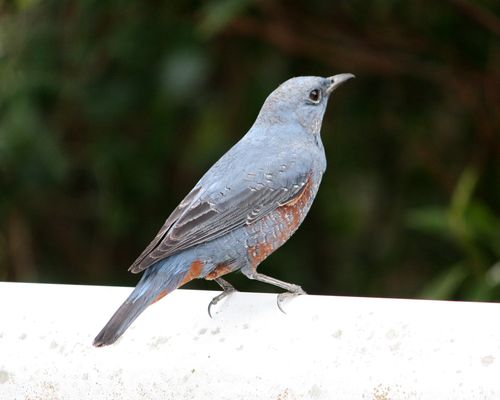CONTRIBUTED BY MARTHA
Oh you little Brother, that brims with full heart, and having nothing, possesses all, surely you do well to sing! For you have life without labor, and beauty without burden, and riches without care. … Therefore sing, Brother, having this great wealth, that when you sing you give your riches to all.
(St. Francis of Assisi’s legendary sermon to the birds, as recorded in Winged Wonders, my paraphrase)
Birds tell you a lot about a place. They flit between our earth and their sky with little concern for us. Their presence indicates that all is well, and their decline or absence is a warning flag that something is awry. With one song or timely appearance they can whisk you into the past with a flood of memories. A crow’s caw puts me in California’s redwoods, a seagull (perhaps shouting “Mine! Mine! Mine!”) puts me in a dirty parking lot in Virginia beach, a cardinal puts me in my parents’ kitchen looking out on snowy trees, and from now on, the memory of a blue rock thrush will fly me to a little Japanese island on the other side of the world from everything I’d known before. Where do birds take you?
It’s possible to walk around completely oblivious to their pervasive beauty, though. I was here for several weeks before I realized that those boring dusky birds that are all over my neighborhood were, in fact, a nuanced navy blue with a rusty belly. I blame the blinding Oki sunlight, to which I was still adjusting. Those are the boys. The blue rock thrush females might be called “brown”, but look at her more closely–she wears shades of ivory, silver, earth, and shadow in a delicate scalloped pattern that makes excellent camouflage. Her huge dark eyes seem surprisingly perceptive.
This dove is another of the most common birds here on island. These two species are relatively boring and don’t even begin to scratch the surface of what you can see here. As an isolated subtropical island on a migration path, this place is a treasure trove of unusual species, and there are several living in the northern expanse of Yanbaru that don’t live anywhere else on earth besides the Ryukyu islands–such as the alliterative Ryukyu robin.
to bird – (verb) to birdwatch, as in “I’m going birding.” Dorky pocket-laden vest optional.
I’m sort of a wannabe birder. I’ve lived here for 9 months and have only gone out specifically to bird once. But the great thing about this hobby is that you can do it while going about your daily life, if you keep your eyes open. Okinawa is an inviting spot–green and lush, it’s an island of nourishment in a vast ocean of nothingness for migrating birds that are built for land. As a result, what sorts of birds you’ll see varies with the season, and something is always relatively easy to spot. Right now the gray-faced buzzards have come to winter here and are noisily occupying the hilltop on which I live. In the course of one normal day, in addition to the birds above I can see Chinese bulbuls, cattle egrets and reef egrets, a kestrel hovering over sugar cane fields, an osprey with a freshly-caught fish in its claws, and three types of wagtail –a sassy little bird that constantly does just what its name suggests. And one of my favorites is the Japanese white eye, a miniscule bird that looks like it was attacked with a whiteout pen.
Spotting a bird can be an everyday pleasure, like seeing an old friend, or it can be surprising and once-in-a-lifetime. You don’t have to be an expert, or even experienced, to see something crazy. On my one real trip on island (with the real birder mentioned in “Resources” below) we spotted a very unusual visitor to the island, the pheasant-tailed jacana, in the rice paddies of Kin. While studying abroad in Panama, I caught a glimpse of the famous resplendent quetzal zooming through the rain forest, and I’ll never forget it. And sometimes a little epiphany will show you how much you have to learn, such as when I photographed this pair of sparrow hawks on the grounds of Zakimi Castle in Yomitan. Here’s the fierce-looking female:
The male is smaller and differently colored, and I thought that I’d given him redeye in my picture. But it turns out that male sparrow hawks actually have red eyes. I love this hobby for the ordinary, the eye-opening, and the thrilling moments.
“But where should I bird??” I hear you cry.  
;W ell, just look up (but be sure to keep your mouth closed–the best birding advice I ever got; their aim could be better than you expect). Your backyard, the playground; check the lampposts when you’re driving across base and the sugar cane fields on your way to the beach. The beach! The park! The castle ruins! You can take a nature walk or bird from your car. (Safely. There’s nothing more terrifying than a birder who is currently birding while at the wheel of a careening van full of ornithology students, and I am speaking from experience here.) Of course, you will eventually have to go out of your way to see something really interesting. If you want to take a special trip, the rice paddies at Kin are chalk full of birds, and the northern Yanbaru forests (so I hear) are even better. And your next duty station will have a whole new set of birdlife. It might be the most portable hobby in the world.
Even a common bird is a little gem of beauty and spunk, its presence a blessing. I hope you’re able to come to appreciate the birds of Okinawa and wherever you live next, and their honored place both in this creation we call nature and in the lives of their human admirers.
Resources:
Amazing pictures of Okinawa birds: These are taken by a birder & photographer named Dan Smith who until recently lived on island. Many, many thanks to Dan for providing the pictures that are linked to above!
Birds of East Asia: China, Taiwan, Korea, Japan, and Russia by Mark Brazil [Princeton Field Guides]. Can be bought on Amazon. A bird book is essential for anyone who’s even sort of interested in birding, and it’s a great place to start. The Foster library also has one field guide available.
Binoculars: get some. Anything is better than nothing. I use $40 Bushnells from Target; the guy mentioned below uses Swarovski binocs that cost more than both of my cars put together. If you’re buying new ones, get them at least 7 x 32 for better birding.
If you’re interested in trying out birding, I can put you in contact with an experienced birder who will take you out on one of his trips. I’d love to put a little group together. Leave a comment for more info.
And, finally, this looks like a good way to get out and see some nature.

